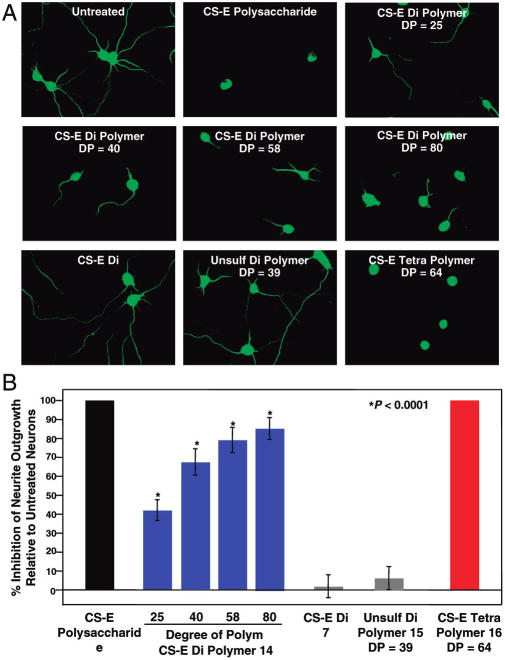Chondroitin sulfate (CS) glycosaminoglycans play critical roles in various physiological processes, including cell division, inflammation, and spinal cord injury.1 However, the complexity of this important class of molecules has hindered efforts to relate structure to function and to generate defined molecular tools for manipulating CS activity. Comprising 40–200 sulfated disaccharide units, CS is thought to contain “blocks” of high and low sulfation, with highly sulfated regions serving as binding sites for growth factors, cytokines, and other proteins.2,3 Although a tetrasaccharide is often sufficient for molecular recognition and neuronal activity,3,4 longer sequences may further enhance protein binding and allow for the assembly of multimeric protein complexes.5 Given the challenges inherent in the synthesis of large oligosaccharides, we sought the development of CS mimetics that would retain key properties of CS polysaccharides, yet be more synthetically accessible. Here, we describe the first synthesis and characterization of CS glycopolymers with defined sulfation sequence and tunable chemical and biological properties.
Surprisingly few polymers based on glycosaminoglycan structures have been reported. Heparin-like glycopolymers have been synthesized from simple monosaccharides such as N-acetyl-D-glucosamine.6 However, no high molecular weight glycopolymers have been assembled from disaccharide building blocks found in heparin/heparan sulfate, chondroitin, dermatan, or keratan sulfate glycosaminoglycans.7 We envisioned that such glycopolymers would more closely mimic the natural polysaccharides (Figure 1), facilitating explorations into the importance of macromolecular structure (e.g., distance, number, and orientation between protein-binding epitopes, multivalency) and providing tools to perturb the functions of CS in vivo.
Figure 1.

Schematic representation of (A) natural CS and (B) CS glycopolymers. Grey and white circles represent the monosaccharide subunits, red circles represent sulfation.
The functional complexity of CS represents a major challenge to the synthesis of glycopolymers as hydroxyl, carboxylic acid, and sulfate groups are reactive under cationic and anionic polymerizations. As such, we explored ruthenium-catalyzed ring-opening metathesis polymerization (ROMP),8 which has been shown to tolerate a broad range of functional groups and affords glycopolymers of controllable length and narrow polydispersity.9 In place of norbornene derivatives used previously,9 we chose cis-cyclooctene monomers, as less constrained scaffolds have been reported to adapt better to biological receptors.10 To ensure a high degree of control over the sulfation pattern, sulfated monomers were used in the polymerization reaction.
We first probed the efficiency of ROMP using disaccharides 6 and 7, which display the biologically active CS-E sulfation motif (Scheme 1). To obtain 6 and 7, trichloroacetimidate11 donor 14 was coupled to the cyclooctene acceptor 2 to afford exclusively the β-linked disaccharide 3 in 69% yield. Removal of the tert-butyldimethylsilyl group using HF·pyridine gave 4, which served as a glycosyl acceptor to assemble tetrasaccharides (Scheme 2). Free radical reduction of the N-trichloroacetyl group and DDQ oxidation of the p-methoxybenzylidene acetal of 3 furnished diol 5 in 82% yield, which gave 6 upon sulfation with sulfur trioxide · trimethylamine complex. Alternatively, desilylation followed by saponification using a sequential LiOOH–NaOH treatment to minimize β-elimination at the C4 position12 gave deprotected monomer 7.
Scheme 1. Synthesis of the Disaccharide Monomera.
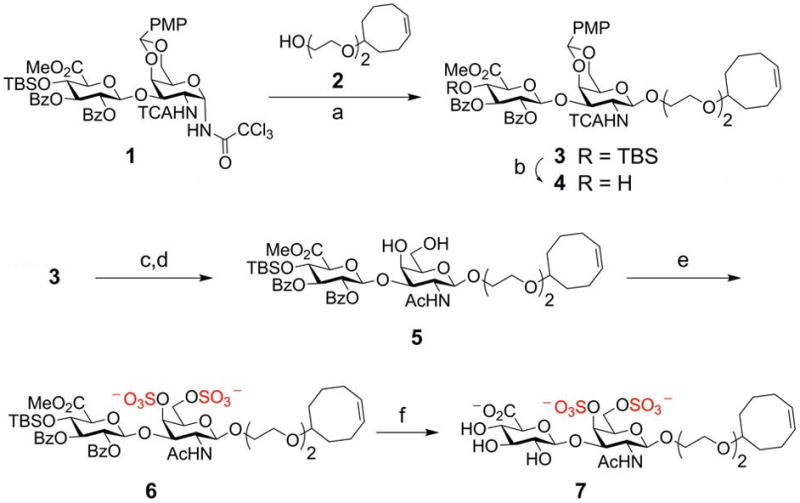
a Conditions: (a) TMSOTf, CH2Cl2, −20 °C, 69%. (b) HF·pyr, THF/pyr, 25 °C, 95%. (c) AIBN, Bu3SnH, benzene, 50 °C, 92%. (d) DDQ, CH3CN/H2O, 25 °C, 89%. (e) SO3·TMA, DMF, 80 °C, 85%. (f) (i) HF·pyr, THF/pyr, 25 °C; (ii) LiOH, H2O2, then NaOH, MeOH, 25 °C, 89% (two steps).
Scheme 2. Synthesis of Protected CS Glycopolymers a.
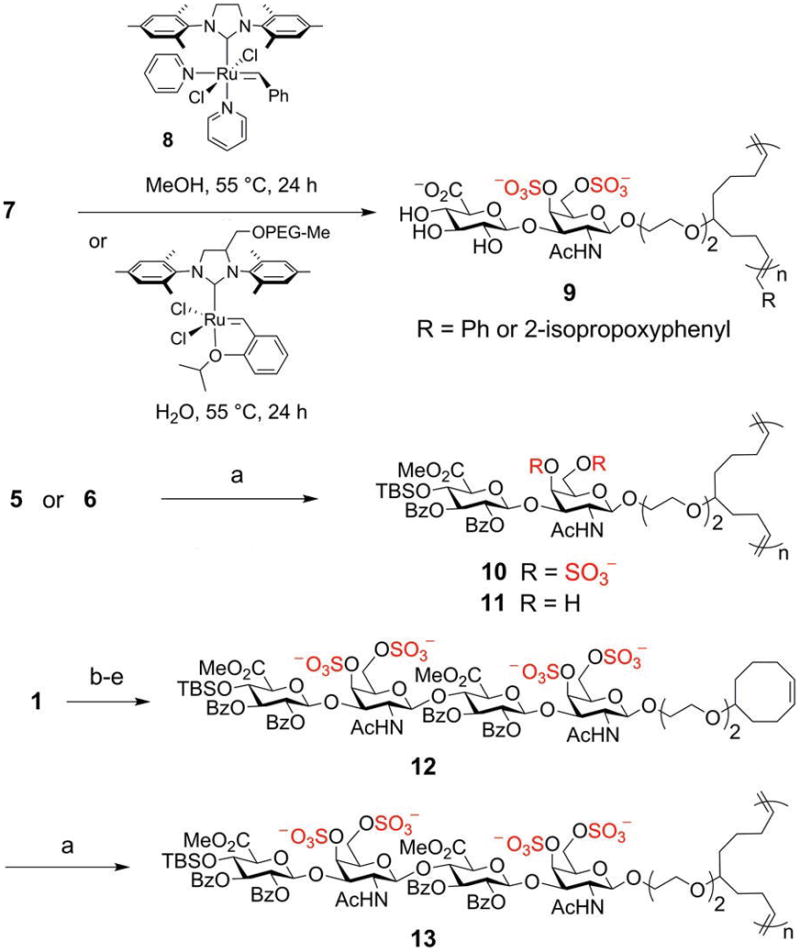
a Conditions: (a) 8, 1:5 MeOH/(CH2Cl)2, 55 °C, 24 h. (b) TMSOTf, 4, CH2Cl2, −20 °C, 45%. (c) AIBN, Bu3SnH, benzene, 50 °C, 89%. (d) DDQ, CH3CN/H2O, 25 °C. (e) SO3·TMA, DMF, 80 °C, 71% (two steps).
ROMP is typically performed in non-coordinating, aprotic solvents. However, the low solubility of 7 under such conditions prompted us to investigate the reaction in polar protic solvents. Polymerization of 7 in MeOH using 2.5 mol % of the fast-initiating catalyst (H2IMes)(Py)2(Cl)2Ru=CHPh (8)9g,13 proceeded to incomplete conversion (36%) and furnished glycopolymer 9 with a low degree of polymerization (DP = 21; Scheme 2). Similarly, ROMP of 7 in aqueous solution using 2.5 or 5.0 mol % of the water-soluble catalyst (H2IMes-poly(ethyleneglycol))(Cl)2Ru=CH(o-iPrOC6H4)14 afforded incomplete conversion (7 or 60%, respectively) and low molecular weight polymers (DP = 8 or 28, respectively). The low conversions and polymer molecular weights are likely due to coordination of the solvent to the catalyst and reactive intermediates, which is expected to reduce the propagation rate and lead to premature chain termination.13b
To address this problem, we explored the polymerization of disaccharide 6, which was soluble in MeOH/(CH2Cl)2 cosolvent mixtures. Reaction of 6 with 2.5 mol % of catalyst 8 in 1:5 MeOH/(CH2Cl)2 at 55 °C afforded complete conversion to glycopolymer 10 with 40 repeating units (Scheme 2 and Table 1, entry 2). Importantly, varying the amount of catalyst (0.5–5.0 mol %) led to a series of glycopolymers with controllable molecular weights (DP = 25–80) and relatively narrow polydispersities (1.24–1.63; entries 1–4). To probe the importance of sulfation, glycopolymer 11, whose pendant disaccharides lack sulfate groups, was also synthesized via polymerization of 5 (entry 5). Finally, we generated glycopolymer 13 containing CS-E tetrasaccharide units from monomer 12 (entry 6). To our knowledge, 13 represents the most functionally complex glycopolymer synthesized to date. All glycopolymers were characterized by 1H NMR spectroscopy and gel permeation chromatography (GPC). The desired CS glycomimetics 14–16 were obtained after desilylation and sequential LiOOH–NaOH treatment in 87–95% yield over two steps (Scheme 3).
Table 1.
ROMP of CS Monomers Using Catalyst 8
| entry | monomer | mol %catalyst | polymer | % yield | n (DP) | Mna (g/mol) | PDIa |
|---|---|---|---|---|---|---|---|
| 1 | 6 | 5.0 | 10 | 88 | 25 | 28 320 | 1.63 |
| 2 | 6 | 2.5 | 10 | 59 | 40 | 43 780 | 1.34 |
| 3 | 6 | 1.0 | 10 | 55 | 58 | 63 400 | 1.35 |
| 4 | 6 | 0.5 | 10 | 53 | 80 | 87 540 | 1.24 |
| 5 | 5 | 2.5 | 11 | 69 | 39 | 36 100 | 1.61 |
| 6 | 12 | 2.0 | 13 | 51 | 64 | 119 000 | 1.33 |
Number average molecular weight and polydispersity index were determined by GPC (0.2 M LiBr in DMF).
Scheme 3. CS Glycomimetics a.
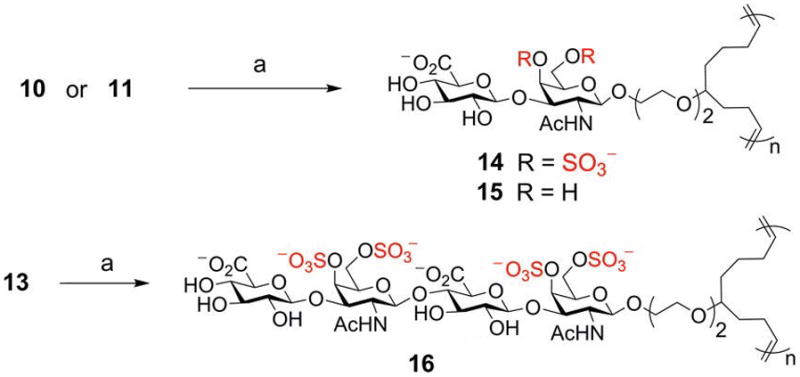
a Conditions: (a) (i) HF·pyr, THF/pyr, 25 °C; (ii) LiOH, H2O2, then NaOH, MeOH, 25 °C, 87–97% (two steps).
We evaluated the biological activity of the glycopolymers by measuring their ability to modulate the outgrowth of hippocampal neurons. Neurons were cultured on poly-DL-ornithine-coated glass coverslips, and each glycopolymer was added in solution to the neurons.15 After 48 h, the neurons were fixed, immunostained with anti-tubulin antibodies, and examined by fluorescence microscopy. We found that natural polysaccharides enriched in the CS-E sulfation motif completely inhibited neurite outgrowth when added in solution at 0.5 μg/mL glucuronic acid concentration to hippocampal neurons (Figure 2). These results are consistent with the model that CS-E present on cell-surface proteoglycans or coated on a substratum recruits growth factors to the cell surface, thereby stimulating downstream signaling pathways involved in neuronal growth.3b,16 By adding CS-E in solution to neurons, growth factors are presumably sequestered away from the cell surface, resulting in neurite inhibition.
Figure 2.
CS-E glycopolymers inhibit the outgrowth of hippocampal neurons. (A) Immunofluorescence images of neurons 48 h after treatment with the indicated compound. A fixed glucuronic acid concentration of 0.5 μg/mL was used in each case to examine the effects of multivalency. The molar concentrations were 14.3 nM for the natural CS-E polysaccharide, 12.1 nM for the CS-E tetrasaccharide polymer, and 16.6–53.0 nM for the disaccharide polymers. See Supporting Information for details. (B) Statistical analysis of neurite length. Error bars represent SEM from three separate experiments. P values are relative to the untreated neurons. See Supporting Information for conditions.
Remarkably, glycopolymer 14 mimicked the activity of the natural polysaccharide (Figure 2). While the isolated disaccharide 7 was insufficient for biological activity, incorporation of the disaccharide into a polymeric framework endowed it with the ability to inhibit neuronal growth. Moreover, the potency of the glycopolymers was valence-dependent: polymers with 25 disaccharide units exhibited moderate activity (40.9 ± 5.4% inhibition), while those with 80 disaccharide units showed significantly enhanced activity (86.0 ± 5.8% inhibition) at the same glucuronic acid concentration. These findings highlight the importance of multivalency in modulating the activity of CS. In addition, the unsulfated glycopolymer 15 had little effect on neurite outgrowth (5.9 ± 5.6% inhibition), confirming earlier observations that sulfation is a prerequisite for activity,4 and further highlighting the ability of these glycopolymers to recapitulate features of natural CS polysaccharides.
Previous studies have shown that a tetrasaccharide represents a minimum functional domain for protein recognition and neuronal growth-promoting activity when adhered to a substratum.3,4 In this solution-based assay, a monovalent tetrasaccharide at 0.5 μg/mL glucuronic acid concentration had minimal activity (Supporting Information). In contrast, glycopolymer 16 at the same glucuronic acid concentration exhibited maximal activity, inducing neurite inhibition to the same extent as the natural polysaccharide (Figure 2). To compare the relative potencies of glycopolymer 16 and the natural polysaccharide, we measured their inhibition values at various concentrations (Figure 3). We were excited to find that the inhibitory potency of 16 was comparable to that of the natural polysaccharide (IC50 values of 1.3 ± 0.1 and 1.2 ± 0.1 nM, respectively), despite considerable changes to the macromolecular structure. These results suggest a surprising flexibility in the way proteins engage CS. We find that a linear orientation of CS epitopes is not required for biological activity. Instead, strategic placement of short epitopes, even in the context of branched structures, is sufficient to recapitulate many of the properties of natural CS glycosaminoglycans.
Figure 3.
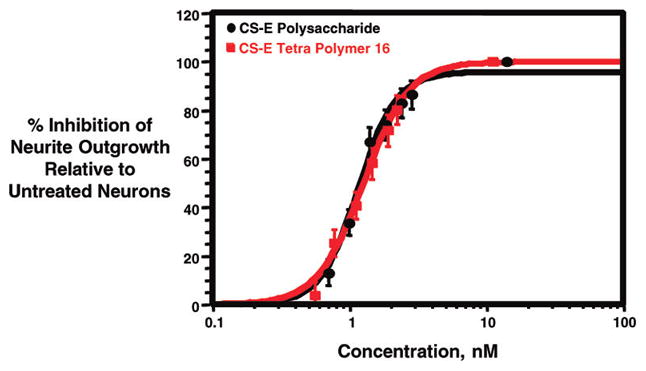
Comparison of the inhibitory potencies of CS glycopolymer 16 and the natural polysaccharide at various concentrations. IC50 values are based on the molar concentration of compound required to inhibit neurite outgrowth by 50% relative to untreated neurons. See Supporting Information for details.
In summary, we have generated novel CS glycomimetics through ROMP of fully protected, sulfated monomers. The polymers recapitulate key features of glycosaminoglycans and display biological activities comparable to those of natural CS polysaccharides. Notably, this approach greatly simplifies the synthesis of complex glycosaminoglycans, providing synthetically accessible, bioactive structures of programmable sulfation sequence. The ability to control the sulfation pattern within the glycopolymer is significant as it should allow for the generation of CS type-specific polymers (e.g., CS–E, CS–A, CS–C) with distinct functions. Our studies highlight the importance of multivalent interactions in amplifying CS activity and suggest an unexpected tolerance for unnatural polymeric architectures. We anticipate that these glycopolymers will be powerful tools for further exploring how the macromolecular structure of CS directs its activity and for manipulating the functions of CS in vivo.
Supplementary Material
Acknowledgments
We thank Prof. Robert H. Grubbs, Dr. Jason P. Jordon, and Dr. Erin Guidry for generous donation of the water-soluble catalyst and for helpful discussions. This work was supported by the American Cancer Society (Grant RSG-05-106-01-CDD), Tobacco-Related Disease Research Program (14RT-0034), and the Howard Hughes Medical Institute.
Footnotes
Supporting Information Available: Experimental procedures and compound characterizations. This material is available free of charge via the Internet at http://pubs.acs.org.
References
- 1.(a) Bradbury EJ, Moon LDF, Popat RJ, King VR, Bennett GS, Patel PN, Fawcett JW, McMahon SB. Nature. 2002;416:636–640. doi: 10.1038/416636a. [DOI] [PubMed] [Google Scholar]; (b) Galtrey CM, Fawcett JW. Brain Res Rev. 2007;54:1–18. doi: 10.1016/j.brainresrev.2006.09.006. [DOI] [PubMed] [Google Scholar]; (c) Gama CI, Hsieh-Wilson LC. Curr Opin Chem Biol. 2005;9:609–619. doi: 10.1016/j.cbpa.2005.10.003. [DOI] [PubMed] [Google Scholar]; (d) Mizuguchi S, Uyama T, Kitagawa H, Nomura KH, Dejima K, Gengyo-Ando K, Mitani S, Sugahara K, Nomura K. Nature. 2003;423:443–448. doi: 10.1038/nature01635. [DOI] [PubMed] [Google Scholar]; (e) Taylor KR, Gallo RL. FASEB J. 2006;20:9–22. doi: 10.1096/fj.05-4682rev. [DOI] [PubMed] [Google Scholar]
- 2.(a) Deepa SS, Umehara Y, Higashiyama S, Itoh N, Sugahara K. J Biol Chem. 2002;277:43707–43716. doi: 10.1074/jbc.M207105200. [DOI] [PubMed] [Google Scholar]; (b) Desaire H, Sirich TL, Leary JA. Anal Chem. 2001;73:3513–3520. doi: 10.1021/ac010385j. [DOI] [PubMed] [Google Scholar]; (c) Li F, Shetty AK, Sugahara K. J Biol Chem. 2007;282:2956–2966. doi: 10.1074/jbc.M609296200. [DOI] [PubMed] [Google Scholar]; (d) Shipp EL, Hsieh-Wilson LC. Chem Biol. 2007;14:195–208. doi: 10.1016/j.chembiol.2006.12.009. [DOI] [PubMed] [Google Scholar]
- 3.(a) Tully SE, Rawat M, Hsieh-Wilson LC. J Am Chem Soc. 2006;128:7740–7741. doi: 10.1021/ja061906t. [DOI] [PubMed] [Google Scholar]; (b) Gama CI, Tully SE, Sotogaku N, Clark PM, Rawat M, Vaidehi N, Goddard WA, III, Nishi A, Hsieh-Wilson LC. Nat Chem Biol. 2006;2:467–473. doi: 10.1038/nchembio810. [DOI] [PubMed] [Google Scholar]
- 4.Tully SE, Mabon R, Gama CI, Tsai SM, Liu X, Hsieh-Wilson LC. J Am Chem Soc. 2004;126:7736–7737. doi: 10.1021/ja0484045. [DOI] [PubMed] [Google Scholar]
- 5.(a) Bao X, Muramatsu T, Sugahara K. J Biol Chem. 2005;280:35318–35328. doi: 10.1074/jbc.M507304200. [DOI] [PubMed] [Google Scholar]; (b) Mohammadi M, Olsen SK, Goetz R. Curr Opin Struct Biol. 2005;15:506–516. doi: 10.1016/j.sbi.2005.09.002. [DOI] [PubMed] [Google Scholar]
- 6.(a) Grande D, Baskaran S, Chaikof EL. Macromolecules. 2001;34:1640–1646. [Google Scholar]; (b) Vazquez-Dorbatt V, Maynard HD. Biomacromolecules. 2006;7:2297–2302. doi: 10.1021/bm060105f. [DOI] [PubMed] [Google Scholar]; (c) Akashi M, Sakamoto N, Suzuki K, Kishida A. Bioconjug Chem. 1996;7:393–395. doi: 10.1021/bc960031c. [DOI] [PubMed] [Google Scholar]; (d) Miura Y, Yasuda K, Yamamoto K, Koike M, Nishida Y, Kobayashi K. Biomacromolecules. 2007;8:2129–2134. doi: 10.1021/bm0701402. [DOI] [PubMed] [Google Scholar]; (e) Hatanaka K, Yoshida T, Miyahara S, Sato T, Ono F, Uryu T, Kuzuhara H. J Med Chem. 1987;30:810–814. doi: 10.1021/jm00388a011. [DOI] [PubMed] [Google Scholar]; (f) Yamaguchi S, Nishida Y, Sasaki K, Kambara M, Kim CL, Ishiguro N, Nagatsuka T, Uzawa H, Horiuchi M. Biochem Biophys Res Commun. 2006;349:485–491. doi: 10.1016/j.bbrc.2006.08.072. [DOI] [PubMed] [Google Scholar]
- 7.de Paz et al. recently reported heparin-based oligodendrimers with eight sugar residues per dendrimer: de Paz JL, Noti C, Bohm F, Werner S, Seeberger PH. Chem Biol. 2007;14:879–887. doi: 10.1016/j.chembiol.2007.07.007.
- 8.Grubbs RH, editor. Handbook of Metathesis. 1–3. Wiley-VCH; Weinheim, Germany: 2003. pp. 1–1204. [Google Scholar]
- 9.(a) Mortell KH, Gingras M, Kiessling LL. J Am Chem Soc. 1994;116:12053–12054. [Google Scholar]; (b) Manning DD, Hu X, Beck P, Kiessling LL. J Am Chem Soc. 1997;119:3161–3162. [Google Scholar]; (c) Gestwicki JE, Strong LE, Kiessling LL. Chem Biol. 2000;7:583–591. doi: 10.1016/s1074-5521(00)00002-8. [DOI] [PubMed] [Google Scholar]; (d) Puffer EB, Pontrello JK, Hollenbeck JJ, Kink JA, Kiessling LL. ACS Chem Biol. 2007;2:252–262. doi: 10.1021/cb600489g. [DOI] [PubMed] [Google Scholar]; (e) Fraser C, Grubbs RH. Macromolecules. 1995;28:7248–7255. [Google Scholar]; (f) Nomura K, Schrock RR. Macromolecules. 1996;29:540–545. [Google Scholar]; (g) Camm KD, Castro NM, Liu Y, Czechura P, Snelgrove JL, Fogg DE. J Am Chem Soc. 2007;129:4168–4169. doi: 10.1021/ja071047o. [DOI] [PubMed] [Google Scholar]
- 10.(a) Krishnamurthy VM, Semetey V, Bracher PJ, Shen N, Whitesides GM. J Am Chem Soc. 2007;129:1312–1320. doi: 10.1021/ja066780e. [DOI] [PMC free article] [PubMed] [Google Scholar]; (b) Mammen M, Chio SK, Whitesides GM. Angew Chem, Int Ed. 1998;37:2755–2794. doi: 10.1002/(SICI)1521-3773(19981102)37:20<2754::AID-ANIE2754>3.0.CO;2-3. [DOI] [PubMed] [Google Scholar]
- 11.Schmidt RR, Kinzy W. Adv Carb Chem Biochem. 1994;50:21–123. doi: 10.1016/s0065-2318(08)60150-x. [DOI] [PubMed] [Google Scholar]
- 12.Lucas H, Basten JEM, Van Dinther TG, Meuleman DG, Van Aelst SF, Van Boeckel CAA. Tetrahedron. 1990;46:8207–8228. [Google Scholar]
- 13.(a) Love JA, Morgan JP, Trnka TM, Grubbs RH. Angew Chem, Int Ed. 2002;41:4035–4037. doi: 10.1002/1521-3773(20021104)41:21<4035::AID-ANIE4035>3.0.CO;2-I. [DOI] [PubMed] [Google Scholar]; (b) Sanford MS, Love JA, Grubbs RH. J Am Chem Soc. 2001;123:6543–6554. doi: 10.1021/ja010624k. [DOI] [PubMed] [Google Scholar]
- 14.Hong SH, Grubbs RH. J Am Chem Soc. 2006;128:3508–3509. doi: 10.1021/ja058451c. [DOI] [PubMed] [Google Scholar]
- 15.Solution studies were chosen to eliminate potential confounding multivalency effects imparted by immobilization of the compounds on surfaces.
- 16.Sotogaku N, Tully SE, Gama CI, Higashi H, Tanaka M, Hsieh-Wilson LC, Nishi A. J Neurochem. 2007;103:749–760. doi: 10.1111/j.1471-4159.2007.04849.x. [DOI] [PubMed] [Google Scholar]
Associated Data
This section collects any data citations, data availability statements, or supplementary materials included in this article.



